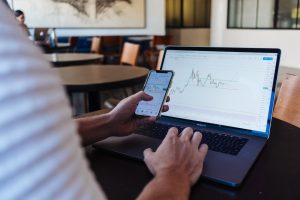Forex trading, also known as foreign exchange trading, is the buying and selling of currencies in order to make a profit. It is a highly volatile market where fortunes can be made or lost in a matter of seconds. In order to properly trade forex, one must have a clear understanding of the market, the tools and strategies available, and the risks involved. In this article, we will explore the key steps to properly trading forex.
Step 1: Understand the Forex Market
The first step to properly trading forex is to understand the market. Forex trading involves buying and selling currencies in pairs, such as EUR/USD or GBP/JPY. The goal is to make a profit by buying a currency at a lower price and selling it at a higher price, or by selling a currency at a higher price and buying it back at a lower price.
The forex market is open 24 hours a day, 5 days a week, and is the largest financial market in the world, with an average daily trading volume of over $5 trillion. It is a decentralized market, meaning there is no central exchange or clearinghouse. Instead, forex trading is conducted through a network of banks and brokers around the world.
Step 2: Choose a Forex Broker
Once you have a clear understanding of the forex market, the next step is to choose a forex broker. A forex broker is a company that provides access to the forex market and allows traders to buy and sell currencies. It is important to choose a reputable broker with a solid track record and good customer service.
When choosing a forex broker, consider factors such as the broker’s reputation, trading platform, fees, and customer support. Look for a broker that offers a user-friendly trading platform, competitive spreads, and a variety of trading tools and resources.
Step 3: Develop a Trading Strategy
Before you start trading forex, it is important to develop a trading strategy. A trading strategy is a set of rules that govern your trading decisions, including when to enter and exit trades, how much to risk on each trade, and which currency pairs to trade.
There are many different trading strategies to choose from, including technical analysis, fundamental analysis, and price action trading. Technical analysis involves using charts and indicators to identify trading opportunities, while fundamental analysis involves analyzing economic and political factors that may impact currency prices. Price action trading involves analyzing price movements and patterns to identify trading opportunities.
Step 4: Practice with a Demo Account
Before you start trading with real money, it is important to practice with a demo account. A demo account is a simulated trading account that allows you to practice trading with virtual money. This allows you to test your trading strategy and get a feel for the market without risking your own money.
Most forex brokers offer demo accounts, and they are free to use. When using a demo account, it is important to treat it as if it were a real account. This means following your trading strategy, managing your risk, and keeping track of your trades.
Step 5: Manage Your Risk
One of the most important aspects of proper forex trading is managing your risk. Forex trading is a high-risk, high-reward market, and it is important to have a solid risk management plan in place.
This includes setting stop-loss and take-profit orders to limit your losses and lock in your profits. It also means only risking a small percentage of your trading account on each trade, typically no more than 2-3%.
Step 6: Monitor the Market
Once you start trading with real money, it is important to monitor the market closely. Keep up to date with economic and political news that may impact currency prices, and be prepared to adjust your trading strategy accordingly.
It is also important to keep a trading journal to track your trades and analyze your performance. This will help you identify areas where you can improve and refine your trading strategy.
Conclusion
Properly trading forex requires a clear understanding of the market, a reputable broker, a solid trading strategy, and effective risk management. By following these key steps, you can increase your chances of success in the highly volatile world of forex trading.






